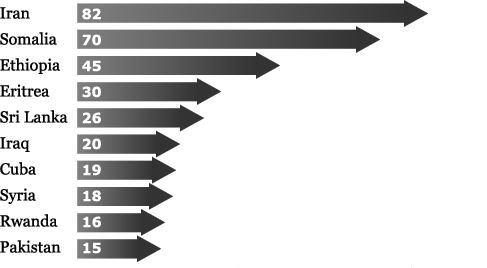Iran remained one of the most censored countries in the world. In the lead-up to the June 2013 presidential elections, then-President Mahmoud Ahmadinejad’s government pre-emptively arrested journalists, banned publications, harassed family members of exiled journalists, and brought the Internet to a slow crawl. Reformist journalists were not the only targets, as various regime factions fought among themselves and attempted to silence their rivals. International journalists had difficulty acquiring visas, and those who did were often subject to strict supervision on the ground. The government said its crackdown on the press was necessary to unravel a foreign conspiracy led by the BBC to undermine the Islamic Republic. But Iranian citizens began to voice hope that a new era of reform would begin with the election of a more moderate president, Hassan Rouhani, and his apparent support from Supreme Leader Ayatollah Ali Khamenei. It was not clear in late year whether that hope would manifest into greater press freedom in the country, and the revolving doors of Iran’s prisons continued to turn.
Iran
» Iranians voice hope for new era with election of President Hassan Rouhani.
» Iran remains one of the world’s worst jailers of journalists.
Iran remained one of the most censored countries in the world. In the lead-up to the June 2013 presidential elections, then-President Mahmoud Ahmadinejad’s government pre-emptively arrested journalists, banned publications, harassed family members of exiled journalists, and brought the Internet to a slow crawl. Reformist journalists were not the only targets, as various regime factions fought among themselves and attempted to silence their rivals. International journalists had difficulty acquiring visas, and those who did were often subject to strict supervision on the ground. The government said its crackdown on the press was necessary to unravel a foreign conspiracy led by the BBC to undermine the Islamic Republic. But Iranian citizens began to voice hope that a new era of reform would begin with the election of a more moderate president, Hassan Rouhani, and his apparent support from Supreme Leader Ayatollah Ali Khamenei. It was not clear in late year whether that hope would manifest into greater press freedom in the country, and the revolving doors of Iran’s prisons continued to turn.
-
82
Journalists in exile -
600
Journalists in anti-state 'plot' -
35
Imprisoned on December 1 -
893
Retweets
At least 82 Iranian journalists sought exile in the past five years, according to CPJ research. CPJ documented more journalists as having fled into exile in recent years from Iran than from any other country in the world. Iranian journalists often seek refuge in Turkey or Malaysia.

Intelligence Minister Heydar Moslehi claimed in March that 600 Iranian journalists were part of an anti-state spy ring associated with the BBC, and that their arrests were an attempt to "prevent the emergence of sedition prior to the elections."
Arrests | Authorities arrested at least 20 journalists between January 26 and March 6 in a broad crackdown aimed at stifling dissent before Iran’s presidential election, according to CPJ research. |
Intimidation | At least 24 family members of BBC and Radio Farda journalists were subjected to harassment and intimidation by authorities, the outlets reported. |
Online restrictions | Beyond its normal censorship of the Internet, the government took extraordinary measures to restrict online speech by using more stringent deep-packet inspection and blocking Virtual Private Networks. These measures caused the number of Iranian users of Tor, a tool to use the Internet anonymously, to plummet by 90 percent before the election, according to the Tor Project. |
Iran remains the second largest jailer of journalists in the world, behind only Turkey. It is not clear whether the election of President Rouhani has had an impact on the imprisonment of journalists in the country. While several journalists have been released, many of those journalists were at the end of their prison sentences and other journalists have been arrested.
Social media sites like Twitter and Facebook are blocked in Iran, even though multiple regime officials have semi-official and even official accounts.
In what the government called a "technical glitch," the sites were unblocked temporarily on September 16, causing much excitement among Iranians. Thomas Erdbrink, a New York Times reporter, received at least 893 retweets when he tweeted, "Hello world, we are tweeting without restrictions from Iran."
@HassanRouhani: | With more than 163,000 followers, this Twitter account supposedly belongs to Iran’s newly elected president, Hassan Rouhani. Although the account is not verified by Twitter, Rouhani staffers have said this is the president’s official account. Some of its tweets strongly suggest it is operated by a staff member close to the president, including breaking details about a direct phone call with President Barack Obama in September. A tweet on September 18 said the president “backs social media,” but does not “personally sit and pen #tweets.” A sister Farsi-language account, @Rouhani_ir, has more than 48,000 followers. |
@JZarif: | Twitter has verified that this account belongs to Iran’s new foreign minister, Javad Zarif. Since the account was opened on September 4 this year, over 112,000 people have signed on to follow Zarif’s English-language tweets. In his first few posts, Zarif caused a buzz by wishing his followers a “Happy Rosh Hashanah” and telling Christine Pelosi, daughter of U.S. Congresswoman Nancy Pelosi, that Iran has never denied the Holocaust. Zarif has also confirmed that he maintains a Facebook page that has more than 800,000 likes. |
@khamenei_ir: | It is unclear whether this Twitter account, with nearly 37,000 followers, is operated directly by the office of Supreme Leader Ayatollah Ali Khamenei. The user tweets in a combination of Farsi and English about the supreme leader’s activities, Iranian policy, and culture, but does not engage in conversations like @HassanRouhani and @JZarif. A sister Facebook page launched in December 2012 has more than 69,000 likes, but its authenticity has also been questioned. Khamenei’s official website, which is offered in 13 different languages, does not link directly to either social media account. |
